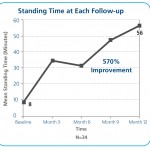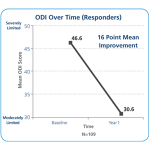The mild Procedure

The mild Procedure for Lumbar Spinal Stenosis: Back Surgery Made Easy
The Mild procedure is safe, outpatient back surgery for patients with lumbar spinal stenosis with 79% having a 70% reduction in pain and increased walking.
The Mild® procedure is a safe outpatient back surgery procedure that can help patients diagnosed with lumbar spinal stenosis (LSS) stand longer and walk farther with less pain. It is a short, outpatient procedure, performed through a very small 5.1 mm incision (about the size of a baby aspirin) that requires no general anesthesia, no implants, and no stitches. Study data show that 79% of patients experience a 70% significant reduction in pain and a significant increase in mobility. In addition, the mild® procedure has been proven to have a very low risk of major complications.
How mild® Works
The mild® procedure has been performed safely on thousands of patients. Doctors who are certified to perform mild® will use an imaging machine and specialized tools to remove small pieces of bone and excess ligament tissue through a tiny incision in your back. Removing these elements restores space in the spinal canal and decreases the compression of the nerves, which reduces pain and restores mobility. Some doctors have described the goal of the procedure as being similar to “removing a kink in a drinking straw” in order to restore adequate blood flow to the spine.
View video to see how you may change your life and start walking and standing longer with less pain. You can view the mild® procedure animation.
Why it Occurs
Lumbar spinal stenosis (LSS) is primarily a degenerative, age-related narrowing of the lower spinal canal that causes pressure on the nerves, leading to pain and reduced mobility. Symptoms typically include pain, tingling, or numbness in the lower back, legs, or buttocks when standing or walking. Discomfort can be relieved by sitting or bending forward. LSS is a common condition, with more than 1.2 million Americans diagnosed and treated each year. Onset generally occurs after age 50.
Symptoms
The symptoms of neurogenic claudication, painful walking due to the spine, caused by spinal stenosis are gradual. If you lean forward to relieve pain while waking, cannot stand or can not walk for more than 20 minutes without pain then you may be a candidate for the mild procedure, a minimally invasive spine surgery done in less than one hour on an outpatient basis in Central Kentucky by Vitality Pain Center physicians.
Studies show marked improvement in function with over 70% of patients getting 70% better with MILD®.
Functional Outcome Improvement – Cleveland Clinic Study at 1 Year3
 Standing time increase: From 8 min. to 56 min. |
 Walking distance increase: From 246 ft. to 3,956 ft. |
Long Term Efficacy – Meta-Analysis I at 1 Year4, 7, 8
 Pain reduced in 81% of patients at 1 year. Mean pain reduced by 53% |
 Mean mobility increased by 34% |
* Cleared for lumbar decompression, Vertos mild is designed to treat lumbar spinal stenosis (LSS).
For more information, visit www.mildprocedure.com.
References
Commonwealth Pain Specialists & Vitality Pain Center have helped over 450 patients from all over Kentucky, as well as connecting states, to get back their life. If you have back pain from Lumbar Spinal Stenosis and Neurogenic Claudication you can be evaluated to see if you would benefit from this minimally invasive procedure that has helped restore function and increase the ability to walk and stand in thousands of patients around the country.
References:
1 Longitudinal Medicare Database, Quorum Consulting.
2 Major complications include dural tear and blood loss requiring transfusion. Weinstein, James N., et al., for the SPORT Investigators. (2008), Surgical vs. Nonsurgical Therapy for Lumbar Spinal Stenosis. New Engl J Med, 358: 794–810. doi: 10.1056/NEJMoa0707136.
3 Mekhail, Nagy, et al. (2012), Functional and Patient-Reported Outcomes in Symptomatic Lumbar Spinal Stenosis Following Percutaneous Decompression. Pain Practice, 12(6): 417–425. doi: 10.1111/j.1533-2500.2012.00565.x.
4 Levy, Robert, et al. (2012), Systematic Safety Review and Meta-Analysis of Procedural Experience Using Percutaneous Access to Treat Symptomatic Lumbar Spinal Stenosis. Pain Medicine, 13(12): 1554-1561. doi: 10.1111/j.1526-4637.2012.01504. 2Responders defined as VAS reductions > 1. 3The published approximate MCID for the ODI version utilized in this study is 6.0 (Fritz, J.M., et al. (2001), A Comparison of a Modified Oswestry Low Back Pain Disability Questionnaire and the Quebec Back Pain Disability Scale. Physical Therapy, 81(2): 776–788.
5 Data provided by Vertos Medical Inc. June 2013.
6 Based on mild® procedure data collected in all clinical trials.
7 Responders defined as VAS reductions ≥ 1.
8 The published approximate MCID for the ODI version utilized in this study is 6.0 (Fritz, J.M., et al. (2001), A Comparison of a Modified Oswestry
Low Back Pain Disability Questionnaire and the Quebec Back Pain Disability Scale. Physical Therapy, 81(2): 776–788.
Contact Details
- King’s Daughters Drive, Suite 100, Frankfort, KY 40601
- Main:502.352.2530
- Toll: 855.4KYPAIN
- Fax:502.352.2534
- Billing: 502.352.2184
- info@cwpain.com
- billing@cwpain.com
- Locations near you
